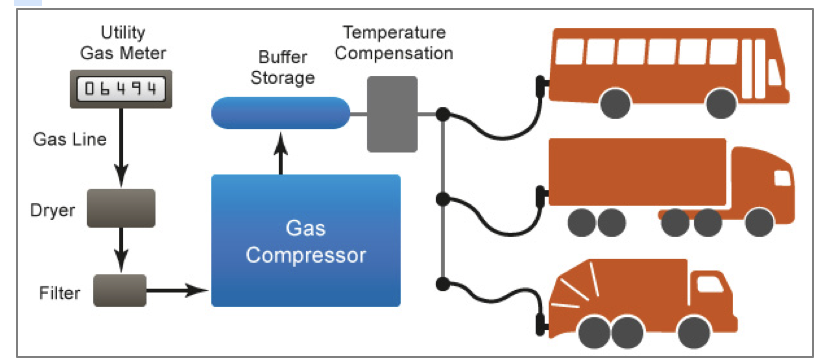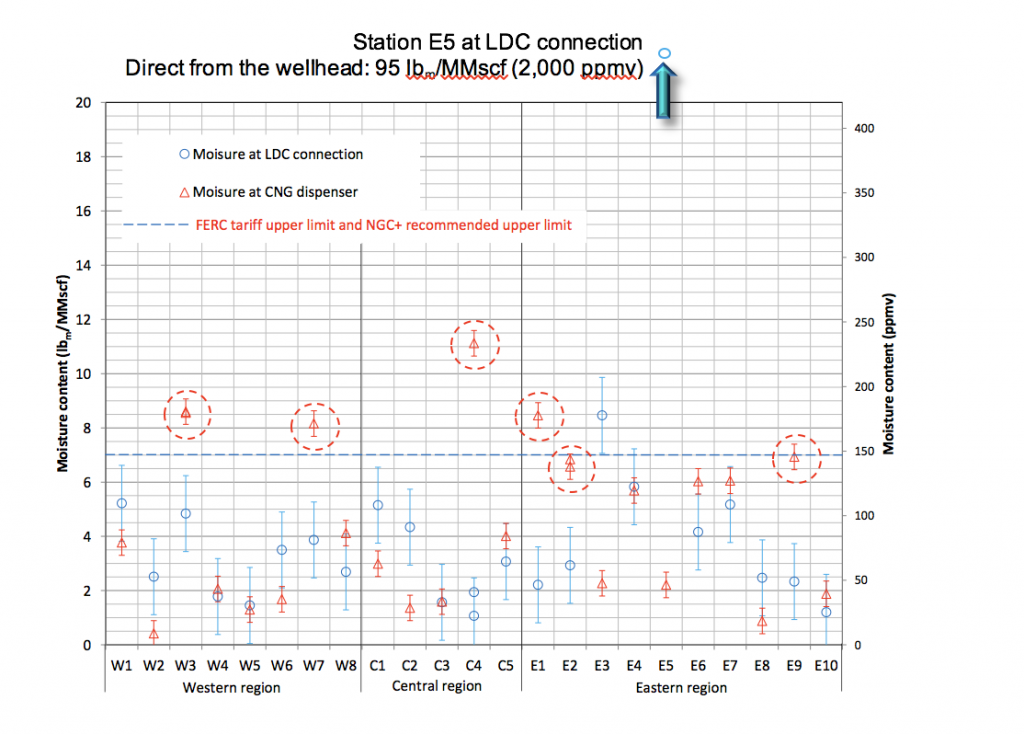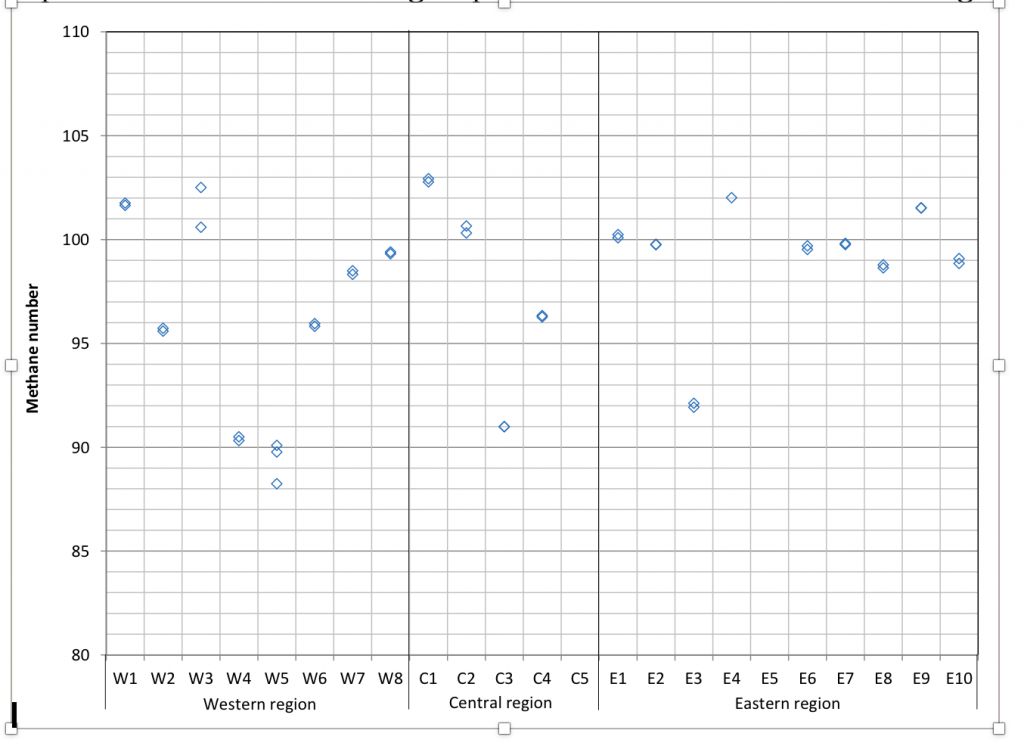July 2016, Vol. 243, No. 7
Features
Natural Gas Vehicles: Accurately Measuring Tank Fills

With the discovery and development of vast domestic gas shales in the United States over the past decade, this expanding energy resource has led to broader appeal of natural-gas-fueled vehicles (NGVs).
Vehicle manufacturers are increasing the number of their NGV offerings, and the natural gas refueling infrastructure in the nation continues to expand. This article focuses on measurement challenges associated with refueling NGVs with compressed natural gas (CNG).
Fueling Infrastructure
As of February, the industry group Natural Gas Vehicles for America reported there was about 153,000 NGVs on U.S. roads, representing less than 1% of the total number of vehicles in the country (estimated to be over 250 million). At that time, about 50 different manufacturers were producing about 100 models of light-, medium- and heavy-duty natural gas vehicles and engines.
As of May 23, there were 915 public and 757 private CNG fueling stations (and 75 public and 60 private LNG fueling stations) in the U.S. By comparison, about 150,000 fuel stations in the U.S. sell gasoline, so the number of CNG stations equals about 1% of that.
The number of existing CNG fueling stations is not sufficient to provide nationwide coverage. For CNG fueling stations, there are essentially two distinct configurations, fast-fill and slow-fill.
Simple schematic of a CNG fast-fill fueling station.
U.S. Department of Energy Alternative Fuels Data Center
Simple schematic of a CNG time-fill fueling station.
U.S. Department of Energy Alternative Fuels Data Center
Fast-fill CNG stations look and operate much like a conventional gas station. The fuel dispensers are similar in form and function and it takes the same amount of time to fill a tank. Time-fill CNG stations typically fuel a vehicle directly from the compressor over an extended period. This approach allows for a smaller compressor, which saves on costs. The time-fill configuration is typically used for fleet applications with the vehicles returning to a central location for extended periods, such as with garbage trucks and school buses.
As NGV fueling stations become more numerous, Coriolis flow meters have generally become the flow element of choice for CNG dispensers. With these meters, the product being measured flows through vibrating tubes to deduce the mass flow rate. The standard quantity of measure for CNG dispensers is the gasoline gallon equivalent, or GGE (equal to 5.66 pounds mass of natural gas).
American Gas Association (AGA) Report No. 11, Measurement of Natural Gas by Coriolis Meter, is considered the U.S. industry standard for Coriolis flow metering technology. This report is not specific to natural gas fuel station metering, but applies to a broader range of natural gas measurement applications.
Other standards related to CNG fueling station measurement include (1) National Fire Protection Association (NFPA) 52, “Vehicular Gaseous Fuel Systems Code,” which lists compositional limits of the CNG; (2) the U.S. National Institute of Standards and Technology (NIST) Handbook 44, “Specifications, Tolerances, and Other Technical Requirements for Weighing and Measuring Devices,” which specifies measurement tolerances for CNG fuel dispensers; and (3) the American National Standards Institute NGV 4.1-99/CSA 12.5-M99 (R2014), “NGV Dispensing Systems,” which covers the configuration of CNG fuel dispensers.
Unsteady Flow
Most fast-fill dispenser units include a microprocessor to control the sequencing of the fueling station’s cascade gas storage system. Because an NGV filling event is an unsteady process, the critical measurement is the totalized flow dispensed to the vehicle fuel tank. However, CNG dispenser manufacturers sometimes quote dispenser flow measurement accuracy based on the steady-state flow accuracy of the meter. Totalized measurement accuracy, if provided, typically will apply only if the flow rate is above a specified minimum threshold. Some manufacturers also state a value for meter repeatability.
Accurately measuring the dispensed CNG is difficult because the gas flow rate, pressure and temperature can vary rapidly during the filling process. Other influences on dispenser measurement accuracy include:
- Flow transients caused by storage tank cascade switching and flow starting and stopping.
- Changes in the gas composition.
- Conversion of volumetric flow to mass flow, including gas quality and density corrections.
- Limited flow rangeability of the meter for the wide range of fueling conditions.
- Gas trapped in the fueling hose at the end of a fill between the meter and the vehicle’s fuel tank.
- The effect of the lower density of CNG (compared to conventional liquid fuels such as gasoline and diesel) on measurement techniques.
The average flow rate for a “fast-fill” of an NGV fuel tank can vary from 40 pounds mass per minute to over 200 pounds mass per minute. Limitations on the fill rate are typically a function of the metering system, noise limits, safety concerns and cost constraints.
Figure 1 is an example of pressure and flow rate transients in a typical NGV fast-fill system having three banks of gas storage reservoirs. This example comes from a lab test program conducted in 1997 using several different commercially available CNG dispensers from that time. For this example, the measured fill time covered the period from when the dispenser was started, with the dispensing nozzle already connected to the vehicle, until the dispenser indicated the fill was complete.
The average flow rate was determined by dividing the dispensed amount of gas by the fill time. Note the peak flow rate for a full tank fill is typically about twice the average rate, which demands the flow meter respond accordingly to a changing rate in order to provide accurate measurement. The reason the average gas flow rate (3.5 GGE/minute) is typically less than the peak rate (7 GGE/minute) is that fuel tank pressure rises during the tank fill, while the storage reservoir pressure usually decreases.
Thus, the pressure difference (i.e., the driving force) between the supply reservoir and the vehicle tank, usually decreases as the tank filling proceeds, and the filling rate slows as a result.
Figure 1: Typical changes in gas dispenser flow rate during a fast-fill process.
To gain acceptance by the National Conference of Weights and Measures (NCWM), CNG dispensers must meet the required measurement tolerance of ±1.5% set by NIST Handbook 44. Figure 2 shows results for dispenser measurement error tests for three different types of CNG flow meters: Coriolis, rotary and Venturi. A weigh scale was used as the measurement reference.
The dispenser measurement error was the percent difference between the dispensed mass reported by each CNG flow meter and the dispensed mass measured by the reference scale. The data show that for a constant gas composition, all three meter types provided relatively equivalent measurement accuracy. Accuracy did degrade, however, as the quantity of gas dispensed decreased, particularly for amounts less than 1 GGE.
Figure 2: Measurement error in total fill amount for a fast-fill CNG dispenser.
CNG dispensers must also be able to fill the fuel tank in a way that provides full vehicle range but does not over-pressurize the tank. Because CNG is stored at a lower fuel density than conventional liquid fuels, storing as much CNG fuel as possible is critical to achieving maximum driving range. Electronic control systems in the CNG dispensers measure temperature, pressure and flow to compute the proper amount of fuel to add to the vehicle tank.
Accurate fill levels cannot be achieved unless the temperature of the gas in the vehicle tank is known. A gas temperature increase of 60° F to 90° F is possible for fills if the tank is initially less than half full. An algorithm in the dispenser control system can compensate for CNG heating during the fill and, therefore, provide a more complete vehicle fill.
CNG Compositional Effects
With advances in shale gas production, biogas, and other unconventional sources of natural gas in the U.S., manufacturers and users of NGVs now have a stake in natural gas quality. The full effect of changing gas supplies on NGV performance is still unclear. Identifying and removing water from NGV gas supplies is critical because high moisture levels in CNG can cause various operational problems. Variation in gas heating value and the effects of contaminants in CNG on NGV performance are less well understood. Consequently, there is now a move to update quality standards for CNG dispensed as NGV fuel.
NGV manufacturers use two CNG quality parameters to design their engines for best performance. The Wobbe index or Wobbe number is related to CNG energy content and the optimum fuel-to-air ratio. Deviations from the optimum value of the fuel’s Wobbe index may result in poor operational and environmental performance by NGVs. The Wobbe index is equal to the higher heating value of the gas divided by the square root of its relative density (i.e., specific gravity).
The second quality parameter is the methane number (MN). This is critical to predicting NGV engine efficiency, just as the octane number is related to the efficiency of gasoline engines. Fuels with lower methane numbers may cause performance problems for NGV engines due to higher amounts of ethane, propane, and heavier hydrocarbons that can cause combustion knocking. Different formulas are used to compute the methane number, but are typically defined so that pure methane has a methane number of 100 and pure hydrogen has a methane number of zero.
Even with “clean, dry” natural gas, changes in gas composition can affect engine performance. The amounts of heavier hydrocarbons and diluents in CNG will affect both the Wobbe index and the methane number, possibly causing efficiency problems. In addition, if large quantities of heavier hydrocarbons (i.e., C7+) are present in CNG, they may condense out and contaminate the fuel system or lead to incomplete combustion and poor performance.
Other CNG quality concerns involve the refueling station equipment. To provide an adequate travel range, CNG is stored onboard NGVs in cylinders at pressures up to 3,600 psig. Natural gas from the local utility must be compressed at the refueling station (and at some stations, stored in pressure vessels) before it is dispensed. Compressor oils used in station compressors may pose problems similar to condensates if they enter the NGV fuel system in large amounts with the CNG. NGV refueling stations include a drying unit, typically a desiccant or a molecular sieve material, to remove excess water vapor from the fuel.
If the dryer has not been regenerated or maintained properly, or if the station receives natural gas with high levels of water vapor that overload the dryer, a significant amount of moisture can pass through the station equipment and into the NGV fuel tank. Excess water vapor has been known to collect in CNG tanks, and in theory, water can potentially form hydrates that can block NGV fuel systems. For this reason, dehydration equipment at refueling stations must be properly maintained and regularly regenerated.
There is little data in the open literature describing the compositional makeup of CNG dispensed from fueling stations in the U.S., or how shale gas may be affecting variability in the composition. The most recent data is from a paper presented at the 2016 Natural Gas Sampling Technology Conference based on a study sponsored by the Coordinating Research Council.
This paper presented field test results from the sampling of dispensed CNG from 23 NGV fueling stations located across the U.S. from December 2013 to February 2014. The results were a “snapshot” of the CNG quality at each station at one point in time, but the analyses were more extensive than previously published data.
Moisture data from all 23 stations (Figure 3) visited during the referenced project and compares the results to the FERC transmission pipeline tariff limit of 7 pounds of water vapor per million standard cubic feet (7 lbm/MMscf) of natural gas. The fueling stations sampled were grouped by time zones with stations in the Pacific and Mountain time zones combined into a single Western region. Of the 23 stations tested, only two (both in the Eastern region) had incoming gas streams exceeding the FERC tariff limit.
Station E5 received unprocessed wellhead gas and the value of 95 lbm/MMscf at the local gas distribution company (LDC) connection for that station was consistent with water-saturated natural gas. By comparison, the CNG at the dispenser for station E5 contained only 2.2 lbm/MMscf of water vapor. The operator of Station E5 regenerated its drying system much more frequently than other stations to maintain this low CNG moisture level.
The moisture levels at the CNG dispenser nozzles were of the most interest. Four of the stations delivered CNG with moisture levels above the typical FERC tariff limit of 7 lbm/MMscf. While FERC limits only apply to pipeline gases, a working dehydration system should lower the moisture content of the incoming gas, and the tariff limit should represent a typical upper limit on CNG moisture content.
At six stations, the moisture level at the CNG dispenser (marked by the red dashed circles) was higher than the moisture level at the LDC connection, and the differences were statistically significant. Independent data from one station confirmed the readings of high CNG moisture content. This suggested an issue with the dehydration systems at these stations, although a review of how gas could absorb moisture during processing was inconclusive. Given these results, moisture levels may be of most concern to automakers that want to avoid issues with their fuel systems.
Figure 3: Measured moisture levels of incoming gas and dispensed CNG at stations around the U.S.
Figure 4 presents the methane numbers of the samples from each station. Since individual NGV engines can have unique performance requirements, gas interchangeability references and tariff documents do not set limits on this parameter. The CNG samples from station E3 had a methane number of 92, more than six units lower than samples from the other stations in the eastern region.
Excluding station E3, the remaining eastern stations presented consistent methane numbers ranging from about 98.5 to 102. In the western and central parts of the country, methane numbers of the CNG samples varied more and ranged from about 88 to 103. The eastern CNG samples were the most consistent, and the average methane number across the eastern region was the highest of the three. Thus, NGVs traveling across the eastern states see the most consistent fuel quality and can expect the most consistent engine performance and least chance for engine knocking.
Figure 4: Methane numbers of CNG samples collected in the U.S.
Overall, the survey findings suggest moisture was not controlled adequately at a significant number of CNG stations. At one station, this was confirmed by instruments at the station itself. The high moisture levels in the dispensed CNG may be related to poor maintenance or poor design of dehydration equipment.
Liquid samples indicated that trace amounts of heavy hydrocarbons, such as compressor oils, were also being carried by the CNG. Except for moisture levels, CNG properties generally fell within typical pipeline tariff limits and the Natural Gas Council+ (NGC+) recommended interchangeability limits. Pipeline gas may deviate from tariff limits for a few days at a time, but it is possible that CNG storage may even out these fluctuations.
To help ensure acceptable quality CNG is delivered to customers, efforts began in early 2016 by the American Society of Testing and Materials (ASTM) International D03 Committee on Gaseous Fuels to develop a new standard entitled, “New Specification for Compressed (CNG) and Liquid Natural Gas (LNG) Used as a Motor Vehicle Fuel.” The standard is being created in parallel with a revision to the Society of Automotive Engineers International (SAE) J1616, entitled “Recommended Practice for Compressed Natural Gas Vehicle Fuel” and issued in May 2016.
CNG Dispenser Calibration
A CNG dispenser’s flow meter should be calibrated periodically. The interval between calibrations is usually specified by the governmental authority responsible for regulating the dispensers in a given geographic area.
The NIST Examination Procedure Outline (EPO) No. 28, entitled “Compressed Natural Gas (CNG) Retail Motor-Fuel Dispensers,” is an excellent reference for guidance on calibrations of CNG dispensers. It is noteworthy that the Fundamental Considerations of NIST Handbook 44 states it is necessary to limit the total error in a measurement standard used without corrections to less than one-third of the tolerance applied to the device under test. For example, if applying the Handbook 44 acceptance tolerance of 1.5% to a CNG dispenser, the test standard must be accurate to at least 0.5%, which can be a challenge.
Conclusion
Detailed information on methods used to measure flow from CNG fuel dispensers is provided herein, as are tips for ensuring measurement accuracy. Information is also provided on the variation in compositional makeup of natural gas delivered for NGV applications.
It is demonstrated how natural gas quality varies from region to region in the U.S., particularly when the gas is produced from the various shale plays. NGV performance can vary as a function of the gas quality, hence, guidance is provided on ways that CNG fueling stations can help deal with variations in gas composition.












Comments